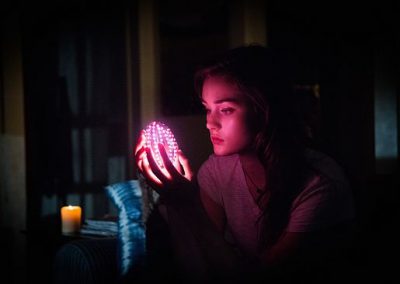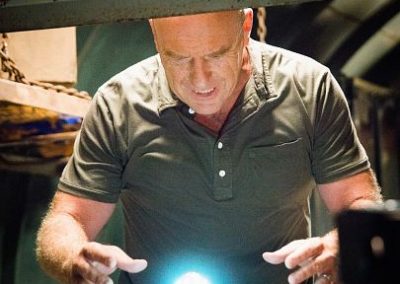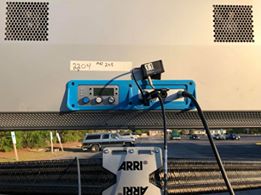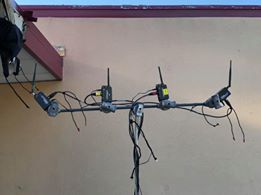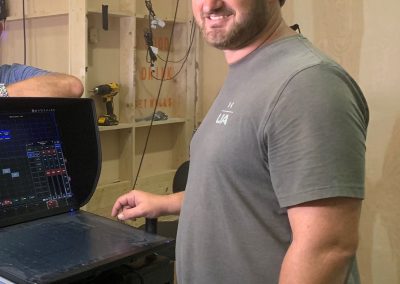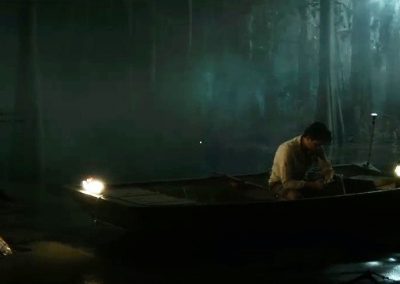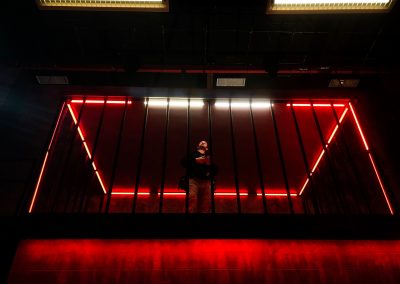“I’ve built my reputation on being the wireless guy since I don’t run any dmx from my cart to my dimmer console, so I’ve made a niche for myself,” states Wilmington, NC-based lighting console programmer Tommy Sullivan Jr. Sullivan’s credits include the SpongeBob Squarepants movie, Swamp Thing; Homeland; and Steven King’s Under the Dome, just to name a few. Some of his success is due to his equipment. “Every single DMX controlled light that we carry on our cart has a RC4 Wireless 900MHz miniature data receiver that we keep on it,” he confides.
Sullivan is also an RC4 Wireless power user. “I have quite the collection of RC4 products; Jim has told me I’m up there with Disney when it comes to the amount of RC4 gear I own,” Sullivan admits. In fact, his collection includes the original RC4 line, RC4Magic, the 900 series and LumenDim devices. Sullivan notes, “I love the RC4 stuff, it’s never let me down”.
Sullivan began working with RC4 equipment in 2014 while he was on the CBS TV drama Under the Dome. Sullivan explains, “I was approached about making an egg that would light up. We explored different options that actors would carry around, and then on cue, it would glow and change colors.” His initial ideas involved wired solutions. “Originally, we were looking at making something that had wires and would be tethered; it would hide a battery pack on the actor. I started doing research online, and stumbled across RC4, and realized that they were also in North Carolina. I thought, ‘this is perfect,’ he says. Sullivan then pulled the metaphorical trigger that would transform his work life. “I gave Jim a call, and got 2.4GHz 2-channel wireless dimmers. I took it, mounted the battery pack inside the egg and it worked perfectly.”
From there, Sullivan moved from the RC4Magic 2.4GHz band to the RC4Magic-900MHz line of products. Sullivan explains, “The 900MHz series of products work better for me because it’s a less congested bandwidth, there are fewer people on it and the range is much better than 2.4. It penetrates stuff better; up here, we have to contend with humidity and rain and all sorts of things that 2.4 doesn’t do well with. The 900 dimmer checks off all the boxes for us and it’s been very reliable.”
One of the challenges that people in all sectors of entertainment have to deal with are buildings and cement; Sullivan has also faced that circumstance. “When I was working on Under the Dome, we shot a lot in an old cement factory that was made completely out of cement. There have been lots of big movies—like Teenage Mutant Ninja Turtles—that shot there going back to the 80s,” Sullivan notes. That’s where he used the RC4Magic-900MHz dimmers. “They worked perfectly,” he reports.
The performance of RC4 gear—especially the 900MHz line—has astonished some of Sullivan’s co-workers. He notes: “I’ve had people come in from out of town on our crew, take a light out in the distance, and say ‘there’s no way you’re going to get signal out to this.’ I push a button; it immediately comes on and they say ‘oh my God.’ “That leads to another happy circumstance. “The next week they’re calling Jim and Aimee to order theirs. Every time I show someone that does what I do, they are instantly turned onto it and end up making a purchase themselves,” Sullivan says with a smile.
The film community in the Wilmington area is a tight-knit one, and Sullivan works hand in hand with his fellow electricians. He has found that the RC4 LumenDim products, which work with Lumen Radio CMRX transmitters, are the perfect solution for many of his props. He explains, “For props, I’ve found it helpful to use the push to pair feature of the LumenDIm dimmers. If a buddy of mine on another show needs to borrow a lantern, I can just give it to him. All he has to do is push it and pair it to his transmitter. We have three shows that are in production in town, and we’re a tight-knit film community, so we share things. Having a push to pair has made that easier.”
RC4 Wireless dimmers aren’t only used for lighting; they’re also great for props. Sullivan has used them for countless lanterns and flashlights, as well as for products that are unique crossovers. He picks up the story: “On Under the Dome, we had a flashlight that the bulb was supposed to explode; then it was supposed to drop on the floor and start vibrating. It was supposed to be possessed.” Creating a possessed flashlight is, as one would imagine, a challenge. “Back then, I was still using the 2.4 system, and I did have some challenges with that, since they wanted it in a Maglite, which was all metal. I had to drill a hole into it to bring the antenna out, and I had to custom-make the battery pack go inside of it. With normal operation, the guys walk around with a flashlight and I was running it at 50%. When it was supposed to blow up, I cranked it up, and the bulb actually blew up,” Sullivan reports.
The story then takes an unexpected turn once the flashlight hits the ground. “Here’s the funny part– I took apart a small personal massager and mounted the motor inside so when the guy dropped it on the concrete, it would start vibrating on the ground. After that, via effects, they made it even more crazy. For what we needed to accomplish on set with the actors, it was perfect,” he reports.
The unexpected surprises continued with the flashlight. Sullivan continues: “Our accountants on the show eventually ended up with the receipt for the vibrator, our Best Boy who does all of the purchasing, got called into the office for it.” It wasn’t the first time that management questioned an unconventional purchase. “The glowing egg that we created, we had to put it underwater, and it comes floating up to the surface. We found the best way to protect it underwater was to use a condom. So, we put the egg in a condom, tightened it up, and sunk it to the bottom. The accountant called him into office for that as well. He explained it and it all worked out, but they had quite a few laughs,” confides Sullivan.
Early on, Sullivan had to call RC4 customer support. “They have hands down the best customer service and technical support of anyone in the market,” Sullivan says. Some of those calls end up going to James D. Smith, RC4’s president and chief product developer. Sullivan adds, “There are not many companies you can call and talk to the developer directly. We’ve spitballed ideas for product improvement, and different ways of doing things and it’s been helpful to have that.”
In the end, Sullivan notes, “I’ve encountered some gaffers—they’re the head of the lighting department—that’s who I work under who say ‘I don’t like wireless, it doesn’t work’.” He has a simple response: “I say you’ve been using the wrong stuff. I’ve had RC4 Wireless equipment work outside for over half a mile away, and still be instantaneous and still do effects that require fast data transmission. It just works flawlessly.”
